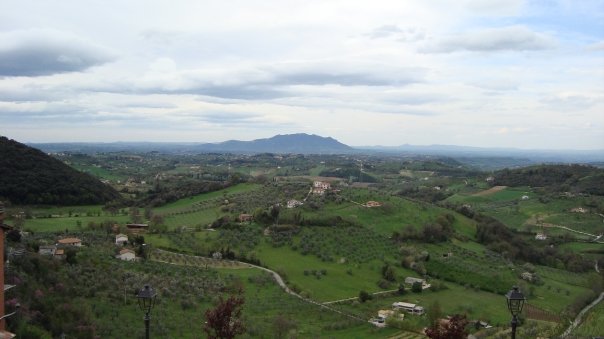 |
| This photo of Monte Soratte courtesy of 06blog.it |
 |
| Google Maps view of Monte Soratte (A) the Tiber valley, and several comunes in the Sabina |
 |
| Monte Soratte by courtesy of Giorgio Clementi |
With a height of 691 metres—2,267 feet, for you Americans—Monte Soratte is no Mt. Fuji or Kilimanjaro.
 |
| Monte Soratte - Mountain of mystery in all its majesty captured by Filippo Simonetti |
 |
| Monte Soratte seen from Poggio Catino, courtesy of Manuel Montanari |
 |
| Monte Soratte from Montopoli courtesy of Filippo Simonetti |
 |
| Monte Soratte by Paolo Pitoni |
 |
| Monte Soratte panorama courtesy of Alessandra Finiti |
 |
| L'eremo di San Silvestro courtesy of tesorintornoroma.it |
There are four other hermitages on the mountain, that of Sant'Antonio, Santa Lucia, San Sebastiano and the church of Santa Romana.
 |
| Ruins of the Church of Santa Romana courtesy of www.teverenotizie.it |
 |
| Festa della Madonna di Maggio photo courtesy of Rome for Free http://freeofchargeinrome.blogspot.ca |
 |
| The bunker entrances during the initial phase of construction courtesy of www.bunkersoratte.it |
The bunkers on Monte Soratte were used during WWII as the headquarters of Nazi Field Marshall Kesselring after he was forced to leave his former headquarters in Frascati. Legend has it that the Nazi's hid a huge treasure in one of the caves under Monte Soratte which to this day has not been recovered.
The following account is written in The Lost Treasure of the Nazis by Noel Richards: The mountain village of San Oreste lies north of Rome and rests at the base of Monte Soratte. The mountain is honeycombed with mine shafts. On May 3, 1944, Nazi SS troops went to Monte Sorrate and in a rock-hewn vault deep within one of its tunnels, hid a fortune worth $72,000,000. The cache consisted of 60 tons of gold bullion siezed by the Germans from the National Bank of Italy, plus a huge amount of jewelry looted by the Nazis from Rome's Jewish community. After depositing the treasure deep in the mountain, they then buried it under thousands of tons of rock with a huge explosion. The lone survivor of this burial escaped only to be sought out and killed later on. Numerous treasure expeditions have sought this hoard without success.
 |
| Casperia's Sta. Maria in Assunta Church with Monte Soratte in the background, courtesy of Giorgio Clementi |
 |
| Clouds and Sunset over Monte Soratte courtesy of Alessandra Finiti |
 |
| Sunset over Soratte by Alessandra Finiti |
My Italian is still not very good, so I am going through it slowly, but I am enjoying what I understand.
 |
| Soratte emerges from the Tiber fog, courtesy of Giorgio Clementi |
 |
| Monte Soratte, courtesy of Andrea Marchetti |
 |
| Monte Soratte and the Tiber fogs, courtesy of Casa Fagiolina in Canneto |
 |
| Monte Soratte at dawn, courtesy of Giorgio Clementi |
 |
| Monte Soratte from Poggio Mirteto, courtesy of Alessandra Finiti |
 |
| Monte Soratte from Catino, courtesy of Giorgio Clementi |
 |
| Monte Soratte from Montpoli, courtesy of Alessandra Finiti |
 |
| Monte Soratte under the moonlight, courtesy of Filippo Simonetti |
 |
| Monte Soratte in the distance seen from Fara in Sabina, courtesy of Alessandra Finiti |
 |
| Monte Soratte from Casperia courtesy of Richard Rooney |
 |
| Monte Soratte with honeysuckle, courtesy of Filippo Simonetti |
 |
| Monte Soratte and light on the Tiber valley, courtesy of Giorgio Clementi |
 |
| Monte Soratte in the rain seen from Vacone, courtesy of Giorgio Clementi |
 |
| Sunset over Sorratte, courtesy of Giorgio Clementi |
 |
| An apartment in Poggio Mirteto with a fabulous view, courtesy of Alessandra Finiti |
 |
| Monte Soratte seen from Canneto in the evening, courtesy of Casa Fagiolina |
 |
| Monte Soratte from Casperia, courtesy of Stefano Aperio Bella |
 |
| Monte Soratte with poppies courtesy of Lorenzo Ballanti |
 |
| Excellent Sabina postcard courtesy of Alessandra Finiti |
I do indeed love Soratte. The next time we visit the Sabina, I hope we can take a day trip with our friends and visit Sant'Oreste, the little village near the southern peak... And then there is that gold...
 |
| Monte Soratte and a splendid Sabine sunset, courtesy of Giorgio Clementi |


Excellent post on one of my favourite mountains! I love it up there. Look one way and you can see the Gran Sasso, look another you can see St. Peter's in the Vatican, look another and it's lago di Bolsena. Stunning, and so close to Rome as well.
ReplyDeleteThanks so much for reading this post and for your comment. We can't wait to visit next time we are in Italy. Unfortunately, the day we planned to go to Sant'Oreste it was raining heavily so we had to call it off.
ReplyDeleteStrepitoso omaggio a una delle montagne più ricche di energia e poesia del Centro Italia ! Molti complimenti, caro James
ReplyDelete